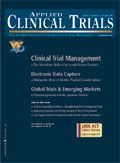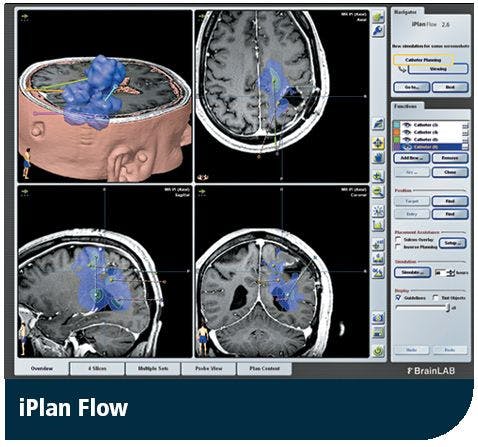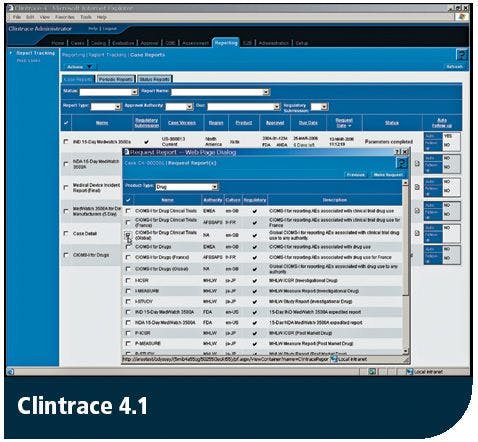Project Leadership: Getting It Right
Applied Clinical Trials
A review of the essential requirements for good project leaders and the crucial role they must play.
Nowadays more and more industries are moving to a "management by objectives" way of business. This is especially true for the pharmaceutical industry in general and clinical trial management in particular.
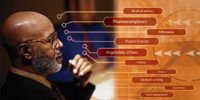
Most clinical trials are operated by trial teams with specific team objectives. The number of project manager positions is exponentially growing as is the number of project management courses. Despite this, leadership in large clinical projects still appears to be a major obstacle.
Without the objective of writing yet another course, this article reviews the key requirements for good clinical project leaders, focusing on potential issues that can lead to project failure if not properly addressed. It is based on the project leadership requirements proposed in a workshop co-moderated by the authors at the 2005 Applied Clinical Trials European Summit in Paris.
Proposition I: A project leader requires exceptional organizational skills
The development of new drugs is a highly specialized business, requiring in-depth knowledge of many clinical, biological, pharmacological, and chemical parameters. The pharmaceutical industry is one of the most highly regulated industries, with many specific and detailed requirements for processes. This makes a successful clinical trial performance by definition a complex effort requiring input from many specialties (see Figure 1).
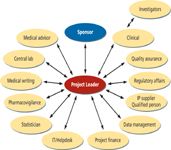
Figure 1
Therefore, many pharmaceutical companies and Contract Research Organizations (CROs) have implemented a matrix project management structure to optimize the performance of clinical project teams. The most crucial role within this team is assumed by the project leader, who is responsible for the entire project, which starts in the trial planning phase and lasts until completion of the study report or manuscript for publication. Thus, highly developed organizational skills are a key prerequisite for effective project management.
Especially in the early project phases, the main emphasis has to go into meticulous planning and preparation. An almost limitless list of items needs to be addressed to ensure that all requirements are met, including:
- project sponsor requirements/expectations
- scope of project, countries involved
- timelines and milestones
- internal project resourcing, training of team members
- third-party providers
- eClinical tools
- budget
- applicable regulations and ethical aspects
- finalization of study protocol, CRF, patient diaries
- investigational product availability.
Addressing these needs requires proper planning and documentation to ensure that the project sponsor and all project team members have the same understanding of directions, tasks, and requirements.
In order to be successful, the Project Management Plan is made up of elaborate plans for statistical analysis, pharmacovigilance, monitoring, project quality management, project communication, etc. Although the majority of plans are usually prepared across most clinical trials, one vital piece is not always present: a risk management plan.
What to do if the trial progress deviates from the plan? What to do when recruitment is slower than forecasted, tolerability less favorable than expected, interim analyses show other results than assumed? A seasoned project leader is prepared for these challenges and manages to redirect its project and the multidisciplinary team according to the new insight.
Proposition II: Effective project leaders care about individuals and their culture
Usually, the technical aspects of project management are rather well taken care of, together with the scientific knowledge that is required. One important element that is frequently ignored, however, is whether the project manager has the right skills to deal with the soft skills of leadership: managing people and dealing with the human and cultural aspects.
Most clinical project teams consist of representatives from different countries, especially when it comes to large Phase III registration trials. Misunderstanding or, worse, neglecting cultural differences will most likely lead to conflicts. To understand cultures, it is important to use a common definition. Culture is the way we interact with each other, how we communicate and behave. Within clinical trial management, cultural differences become most evident in team communication.
People from different countries use different ways to express themselves. One aspect of this is the level of context in which a message is given. Mediterranean Europeans as well as Asians usually communicate in a high-context way.1 Messages are implicit and the topic is not directly addressed. Instead, the communicator goes a long way—using many words and examples—to have you understand his opinion without simply saying "yes" or "no," as this is regarded as impolite. In contrast, Northern Europeans like Dutchmen and Germans tend to communicate in a direct way, often by simply saying "yes" or "no." Usually, this is just the expression of a business opinion without any personal intention behind it. This is, however, not always recognized and appreciated by high-context cultures, who often regard it as blunt or rude.
The situation becomes even more complex when one realizes that within one country there may also be different cultures within different disciplines. As pointed out earlier, clinical trial conduct is a multidisciplinary approach bound to encounter the related challenges. Technically oriented professionals such as research physicians and statisticians tend to communicate in a more low-context way compared to human resource and marketing professionals. Awareness and consideration by the project leader will almost certainly improve outcomes by avoiding conflicts based on cultural differences.
An underestimated challenge is language. Although English is the global pharma language, for many people it is not their first one. This means that messages could become lost or be wrongly interpreted. This again could lead to decreased motivation by team members, as they might get the feeling that they are continuously misunderstood or disregarded. Therefore, an appropriate amount of time should be given to every team member to let them express their opinion.
The reason why cultural aspects are often disregarded within clinical trial management has to do with several organizational pharma "myths"2 :
- it is a data-driven industry—culture is secondary.
- company culture is stronger than individual country culture.
- science has its own language, and that is something we all understand.
- no one has ever complained or admitted to difficulties with understanding.
Although these myths may contain some level of truth, in reality, cultural differences will always be there. The above claims are to some extent proof that those differences are often disregarded.
Proposition III: The best project managers are also outstanding leaders
Apart from cultural aspects, personal aspects are important to be a successful team leader. People learn differently and work and make decisions in different ways. A team member's style may be so different from the project leader's style that he/she has a detrimental influence on team output. Over the past decades, many models have been developed to describe and categorize differences in individual human and cultural behavior. The example in Figure 2 (the Whole Brain™ Model3 ) illustrates why it is useful to understand this.

Figure 2
The model categorizes people into four segments/areas of thinking styles. In the top left quarter (A) people are characterized by logical and analytical, fact-based thinking. The lower left quadrant (B) depicts the well-organized and detailed person. The lower right quadrant (C) contains the people that are interpersonal and emotional. The top right quadrant (D) characterizes people by a holistic approach, integration of information, and synthesis of new ideas.
Important clinical trial functions have different thinking preferences. Scientific project advisors tend to have an "A" dominance, clinical monitors and data managers a "B," project assistants a "C," and leaders of entire development programs a "D" dominance. The project leader should ideally have a healthy proportion of each of the four group characteristics.
One can easily imagine that a project team with such different characteristics will have difficulties performing if proper attention is not given to those differences. A good project leader first of all needs to understand his/her own characteristics and the traits that he/she may be lacking. Understanding one's shortfalls, in fact, can itself be a powerful management tool.
The second task of a project leader is to learn about team members' characteristics. It might be advisable for every team to choose one of the available models and categorize each team member. By so doing, team members may better understand their colleagues and avoid conflicts.
The third step is to make sure every team member is assigned to a role that is in line with their personal characteristics. This minimizes the risk of members failing to meet their objectives and usually increases job satisfaction.
Proposition IV: Project leadership is one role and line management is another
The real world most often differs from the ideal. This is especially true for team member selection. Within the pharma industry, project teams tend to be assembled using currently available functions without taking into account the above considerations. Teams need a research scientist, statistician, and monitors. Most often they are taken from the organization and not newly hired. Apart from this, and as previously mentioned, these team members often have to operate in a matrix system, being a part of several project teams and having to report to different project and line managers. The consequence of this is that the project leader is confronted with a team without a chance to carefully select the team members.
This raises the question: Is it appropriate for the project leader to be the line manager of individual project team members? A line management role is fundamentally different from a project management function. A project leader has to control the project timelines and budgets and ensure that the deliverables meet all requirements; whereas, line managers must make sure that their direct reports are optimally prepared for the assigned tasks. A project leader would too easily be distracted from the main objectives if he/she were responsible for the day-to-day management of the team members.
Proposition V: Leading rather than managing a project is the difference between unbounded success and miserable failure4
As all the previous topics are generally well known and acknowledged within the industry, why do some project leaders still fail? First of all, it should be clear by now that a project leader requires many specific skills. A project leader should, therefore, be clearly qualified for his/her function by having shown organizational, negotiation, communication, and general leadership skills.5,6 Too often, excellent contributors in a specific field are "rewarded" for their previous efforts and promoted to project leader without taking all the required skills into consideration. Not every excellent research scientist or monitor has the capabilities for becoming a project leader. Secondly, there often is the temptation of focusing too much on those project tasks that relate to their background (e.g., monitoring or statistics). This specialist approach leads to a huge workload, the micromanaging of certain team members and disregard of others, and loss of direction.
The reason for failure does not always lie with the project leader. Many projects are bound to fail due to eminent omissions in other places. Sometimes the timelines are unrealistically short or the available budget is far too limited to successfully complete a project. Many times the reason for failure is a total lack of empowerment of the project leader.
Many projects are slowed down due to the fact that they are not fully endorsed by senior management, resulting in limited cooperation. On the other hand, projects can also be of such importance that this leads to excessive management involvement. This is seen especially when a pharmaceutical sponsor is micromanaging the CRO that runs the project. Distrust and continuous checks and modifications can bring a project to a halt. It requires qualities like professional competence, diligence, patience, and—above all—appropriate political skills for the project leader to keep such a project on track.
In conclusion, it is inevitable that major emphasis must be placed on the development of good clinical project leaders to ensure effective conduct of major clinical trials.
References
1. L.A. Samovar and R.E. Porter, Communication Between Cultures, 5th Ed. (Wadsworth Publishing, Belmont, CA, 2003).
2. I.G. Asherman, "Language, Culture, and the Development Process," DIA Today, 5, 28–30 (2005).
3. N. Herrmann, The Whole Brain Business Book (McGraw-Hill, New York, 1996).
4. D. Artt, "It's Not About Project Management...It's About Project Leadership!" PMFORUM, November-December 2001, http://www.pmforum.org/library/papers/2001/1112papers.htm#01.
5. L.A. Hill, Becoming a Manager: Mastery of a New Identity (Harvard Business School Press, Boston, 1992).
6. R. Charan, S. Drotter, J. Noel, The Leadership Pipeline: How to Build the Leadership-Powered Company (Jossey-Bass, San Francisco, 2001).
Jan Koedam,* is medical affairs manager with Celgene, The Netherlands, email: jkoedam@celgene.comJohanna Schenk, MD, FFPM, is senior partner and managing director with PharmaProjekthaus GmbH & Co. KG, Frankfurt, Germany.
*To whom all correspondence should be addressed.
